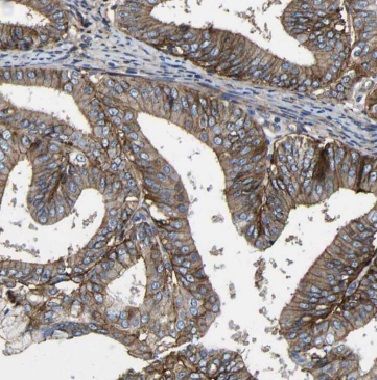Products
BVES antibody
| Size | Price |
|---|---|
| 100µg | Inquiry |
- SPECIFICATIONS
- FIGURES
- CONDITIONS
- FAQS
- Product Name
- BVES antibody
- Catalogue No.
- FNab00992
- Size
- 100μg
- Form
- liquid
- Purification
- Immunogen affinity purified
- Purity
- ≥95% as determined by SDS-PAGE
- Clonality
- polyclonal
- Isotype
- IgG
- Storage
- PBS with 0.02% sodium azide and 50% glycerol pH 7.3, -20℃ for 12 months(Avoid repeated freeze / thaw cycles.)
- Immunogen
- blood vessel epicardial substance
- Alternative Names
- Blood vessel epicardial substance (hBVES)|Popeye domain-containing protein 1 (Popeye protein 1)|BVES|POP1|POPDC1 antibody
- UniProt ID
- Q8NE79
- Observed MW
- 41-70 kDa
- Tested Applications
- ELISA, WB, IHC
- Recommended dilution
- WB: 1:100-1:1000; IHC: 1:20-1:200
 mouse skeletal muscle tissue were subjected to SDS PAGE followed by western blot with FNab00992(BVES antibody) at dilution of 1:500
mouse skeletal muscle tissue were subjected to SDS PAGE followed by western blot with FNab00992(BVES antibody) at dilution of 1:500
 Immunohistochemistry of paraffin-embedded human ovary tumor using FNab00992(BVES antibody) at dilution of 1:100
Immunohistochemistry of paraffin-embedded human ovary tumor using FNab00992(BVES antibody) at dilution of 1:100
- Background
- Cell adhesion molecule involved in the establishment and/or maintenance of cell integrity. Involved in the formation and regulation of the tight junction(TJ) paracellular permeability barrier in epithelial cells(PubMed:16188940). Plays a role in VAMP3-mediated vesicular transport and recycling of different receptor molecules through its interaction with VAMP3. Plays a role in the regulation of cell shape and movement by modulating the Rho-family GTPase activity through its interaction with ARHGEF25/GEFT. Induces primordial adhesive contact and aggregation of epithelial cells in a Ca(2+)-independent manner. Also involved in striated muscle regeneration and repair and in the regulation of cell spreading(By similarity). Important for the maintenance of cardiac function. Plays a regulatory function in heart rate dynamics mediated, at least in part, through cAMP-binding and, probably, by increasing cell surface expression of the potassium channel KCNK2 and enhancing current density(PubMed:26642364). Is also a caveolae-associated protein important for the preservation of caveolae structural and functional integrity as well as for heart protection against ischemia injury.
How many times can antibodies be recycled?
First, usually it's not suggested to recycle antibodies. After use, buffer system of antibodies has changed. The storage condition of recycled antibodies for different customers also varies. Thus, the performance efficiency of recycled antibodies can’t be guaranteed. Besides, FineTest ever conducted the antibody recycling assay. Assay results show recycling times of different antibodies also varies. Usually, higher antibody titer allows more repeated use. Customers can determine based on experimental requirements.
Notes: After incubation, we recycle rest antibodies to centrifuge tube and store at 4℃. High titer antibodies can be stored for a minimum of one week. Reuse about three times.
What are components of FineTest antibody buffer?
Components of FineTest antibody buffer are usually PBS with proclin300 or sodium azide, BSA, 50% glycerol. Common preservative is proclin300 or sodium azide, which is widely applied in the lab and industry.
How about the storage temperature and duration of FineTest antibodies?
Most antibodies are stored at -20℃. Directly-labeled flow cytometry antibodies should be stored at 2 - 8℃. The shelf life is one year. If after sales issues for purchased antibodies appear, return or replacement is available. Usually, antibodies can be still used after the one-year warranty. We can offer technical support services.
Is dilution required for FineTest antibodies? What’s the dilute solution?
Directly-labeled flow cytometry antibodies are ready-to-use without dilution. Other antibodies are usually concentrated. Follow the dilution ratio suggested in the manual. Dilute solution for different experiments also varies. Common antibody dilution buffers are acceptable(e.g. PBST, TBST, antibody blocking buffer).
How to retrieve antibodies for immunohistochemistry?
Common retrieval buffers: Tris-EDTA Buffer(pH 9.0); Citrate Buffer(pH 6.0)
Heat induced antibody retrieval:
Method 1: Water-bath heating: Put the beaker with retrieval buffer and slide in the boiling water bath. Keep the boiling state for 15min. Naturally cool to room temperature;
Method 2: Microwave retrieval: Put the beaker with retrieval buffer and slide in the microwave oven. Heat at high power for 5min, Switch OFF for 3min, Heat at medium power for 5min. Naturally cool to room temperature.
How to choose secondary antibodies?
(1) Secondary antibodies react with primary antibodies. Thus, secondary antibodies should be against host species of primary antibodies. E.g. If the primary antibody is derived from rabbit, the relevant secondary antibody should be against rabbit. E.g. goat anti rabbit or donkey anti rabbit.
(2) Choose secondary antibody conjugates according to the experimental type, e.g. ELISA, WB, IHC etc. Common enzyme conjugated secondary antibodies are labelled by HRP, AP etc. Fluorescin or dye labelled secondary antibodies are applied in immunofluorescence and flow cytometry(e.g. FITC, Cy3).
